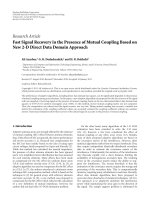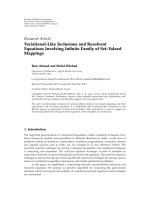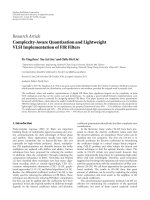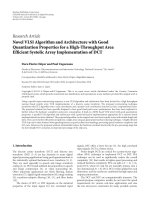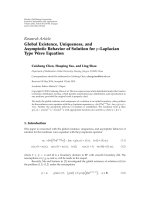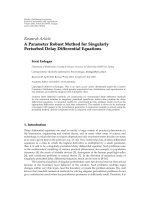báo cáo hóa học:" Research Article Local Smooth Solution and Non-Relativistic Limit of Radiation Hydrodynamics Equations" pptx
Bạn đang xem bản rút gọn của tài liệu. Xem và tải ngay bản đầy đủ của tài liệu tại đây (529.42 KB, 15 trang )
Hindawi Publishing Corporation
Boundary Value Problems
Volume 2010, Article ID 716451, 15 pages
doi:10.1155/2010/716451
Research Article
Local Smooth Solution and Non-Relativistic Limit
of Radiation Hydrodynamics Equations
Jianwei Yang,
1
Shu Wang,
2
and Yong Li
2
1
College of Mathematics and Information Science, North China University of Water Resources and
Electric Power, Zhengzhou 450011, China
2
College of Applied Sciences, Beijing University of Technology, PingLeYuan100, Chaoyang District,
Beijing 100022, China
Correspondence should be addressed to Jianwei Yang,
Received 5 May 2010; Accepted 16 July 2010
Academic Editor: Donal O’Regan
Copyright q 2010 Jianwei Yang et al. This is an open access article distributed under the Creative
Commons Attribution License, which permits unrestricted use, distribution, and reproduction in
any medium, provided the original work is properly cited.
We investigate a multidimensional nonisentropic radiation hydrodynamics model. We study the
local existence and the convergence of the nonisentropic radiation hydrodynamics equations via
the non-relativistic limit. The local existence of smooth solutions to both systems is obtained. For
well-prepared initial data, the convergence of the limit is rigorously justified by an analysis of
asymptotic expansion, an energy method, and an iterative scheme. We also establish uniform a
priori estimates with respect to .
1. Introduction
In this paper, we study a system of PDEs describing radiation-driven perfect compressible
flows, in particular in astrophysics cf. 1–4. Assuming that the radiative temperature and
the fluid temperature are equal, and that the gas is radiatively opaque so that the equilibrium
diffusion will be dealt with, and the mean free path of photons is much smaller than the
typical length of the flow, then, we can write the equations of radiation hydrodynamics
without radiative heat diffusivity in R
d
, describing the conservation of mass, momentum
and energy, as see 2, 3, 5
∂
t
ρ div
ρu
0,
∂
t
ρu
div
ρu ⊗ u
∇
p
1
3
θ
4
0,
∂
t
E div
E p
1
3
θ
4
u
0,
1.1
2 Boundary Value Problems
for x, t ∈ R
3
× 0,T,T>0, where ρ, u u
1
, ,u
d
T
,p,and θ denote the density, velocity,
thermal pressure, and absolute temperature, respectively, 8π
5
k
4
/15h
3
c
3
> 0isaradiation
constant, and c is the light speed, and
E
1
2
ρu
2
ρe θ
4
1.2
is the total energy, e eρ, θ is the internal energy, and u
2
d
i1
u
2
i
is the square of the
macroscopic velocity.
From 1.1 and 1.2, we see that the system includes both gas and radiative
contributions to flow dynamics. The quantities 1/3θ
4
and θ
4
represent the radiative
pressure and radiative energy density, respectively. To complete system 1.1, one needs
the equation of state for the pressure p pρ, θ. In this paper, for the purpose of our test
problems, we will limit our study to the polytropic ideal gases, namely: p Rρe γ − 1ρe
with γ>1 being the specific heat ratio and e c
V
θ with c
V
being the specific heat; we assume
c
V
1 without loss of generality.
We point out that if one assumes → 0in1.1, then system 1.1 reduces to the usual
inviscid Euler equations:
∂
t
ρ
0
div
ρ
0
u
0
0,
∂
t
ρ
0
u
0
div
ρ
0
u
0
⊗ u
0
∇p
0
0,
∂
t
E
0
div
E
0
p
0
u
0
0,
1.3
which are nonisentropic and compressible Euler equations.
The aim of this paper is to justify rigorously the local existence of smooth solutions of
system 1.1 and the convergence of system 1.1 to this formal limit equations 1.3.
Concerning the non-relativistic limit c →∞,thatis, → 0, there are only partial
results. Indeed, we know that the phenomenon of non-relativistic is important in many
physical situations involving various nonequilibrium processes. For example, important
examples occur in inviscid radiation hydrodynamics 6, in quantum mechanics 7, in Klein-
Gordon-Maxwell system 8, in Vlasov-Poisson system 9, in Euler equations 10,inEuler-
Maxwell equations 11, 12,andsoon.
In this paper, we are interested in the nonrelativistic limit → 0 in the problem
1.1 for the radiation hydrodynamics equations. We prove the existence of smooth solutions
to the problem 1.1 and their convergence to the solutions of the compressible and
nonisentropic Euler equations in a time interval independent of . For this propose, we use
the method of iteration scheme and classical energy method. The convergence of the radiation
hydrodynamics equations to the compressible and nonisentropic Euler equations is achieved
through the energy estimates for error equations derived from 1.1 and it’s formal limit
equations 1.3.
The remainder of this paper is arranged as follows: In the next section, we give the
local smooth solutions to both system 1.1 and 1.3. Section 3 is devoted to justify the
convergence of
1.1 to 1.3. By formal analysis, we show that the leading profiles of the
density, velocity, and temperature with respect to satisfy a compressible nonisentropic
Euler equations, and their next order profiles satisfy the corresponding linearized equations.
Boundary Value Problems 3
The Cauchy problem for this nonisentropic Euler equations is solved in this section. The final
part is devoted to rigorously justifying the asymptotic expansion developed in Section 3 and
obtaining the convergence of solutions to the multidimensional compressible nonisentropic
Euler system in a time interval independent of .
Notations and Preliminary Results
1 Throughout this paper, ∇ ∇
x
is the gradient, α α
1
, ,α
d
and β are multi-
indeices, and H
s
R
d
denotes the standard Sobolev’s space in R
d
, which is defined by Fourier
transform, namely, f ∈ H
s
R
d
if and only if
f
2
s
2π
d
k∈Z
d
1
|
k
|
2
s
Ff
k
2
< ∞,
1.4
where Ffk
R
d
fxe
−ikx
dx is the Fourier transform of f ∈ H
s
R
d
.
2 Also, we need the following basic Moser-type calculus inequalities see,
Klainerman and Majda 13, 14:forf, g, v ∈ H
s
and any nonnegative multi-index α, |α|≤s,
D
α
x
fg
L
2
≤ C
s
f
L
∞
D
s
x
g
L
2
g
L
∞
D
s
x
f
L
2
,s≥ 0, 1.5
D
α
x
fg − fD
α
x
g
L
2
≤ C
s
D
x
f
L
∞
D
s−1
x
g
L
2
g
L
∞
D
s
x
f
L
2
,s≥ 1, 1.6
D
s
x
Av
L
2
≤ C
s
s
j1
D
s
x
Av
L
∞
1
∇v
L
∞
s−1
D
s
x
v
L
2
,s≥ 1.
1.7
3Sobolev’s inequality. For s>d/2,
f
L
∞
≤ C
s
f
s
. 1.8
4 If s>d/2, then for f, g ∈ H
s
and |α|≤s,
D
α
x
fg
L
2
≤ C
s
f
s
g
s
. 1.9
2. The Local Existence
In this section, we give our main result about local existence. For this purpose, we first rewrite
the system 1.1 as a symmetric hyperbolic system of first order. Then, we prove the local
existence and uniqueness of smooth solutions to the Cauchy problem for 1.1.
4 Boundary Value Problems
For smooth solutions, the system 1.1 can be rewritten as follows:
∂
t
ρ div
ρu
0,
∂
t
u
u ·∇
u
Rθ
ρ
∇ρ
R
4θ
3
3ρ
∇θ 0,
∂
t
θ
u ·∇
θ
Rθ
4/3 − 4R
θ
4
ρ 4θ
4
div u 0.
2.1
In fact, 2.1 is a non-relativistic, non-isotropic, and compressible Euler equations.
For convenience, we introduce the following two functions:
f
1
ρ, θ
4θ
3
3ρ
,
f
2
ρ, θ
4/3 − 4R
θ
4
ρ 4θ
4
.
2.2
Then, 2.1 can be rewriten as follows:
∂
t
ρ div
ρu
0,
∂
t
u
u ·∇
u
Rθ
ρ
∇ρ
R f
1
∇θ 0,
∂
t
θ
u ·∇
θ
Rθ f
2
div u 0.
2.3
Denote the vector and matrix
V
ρ, u,θ
T
,
A
j
V
u
j
I
d2×d2
⎛
⎜
⎜
⎜
⎜
⎜
⎜
⎜
⎝
0 ρe
T
j
0
Rθ
ρ
e
j
0
R f
1
e
j
0
Rθ f
2
e
T
j
0
⎞
⎟
⎟
⎟
⎟
⎟
⎟
⎟
⎠
, 2.4
where e
1
, ,e
d
is the canonical basis of R
d
and y
i
denotes the ith component of y ∈ R
d
.
Thus, we can rewrite the system 2.3 as follows:
∂
t
V
d
j1
A
j
V
∂
x
j
V 0.
2.5
We will study the Cauchy problem for 2.5 together with the initial data
V
x, 0
V
0
x
,x∈ R
d
.
2.6
Boundary Value Problems 5
It is not difficult to see that the equations of V in 2.5 are symmetrizable and
hyperbolic. If we introduce the d 2 × d 2 matrix
A
0
V
⎛
⎜
⎜
⎜
⎜
⎜
⎜
⎜
⎝
ρ
−1
00
0
ρ
Rθ
0
00
ρ
R f
1
Rθ
Rθ f
2
⎞
⎟
⎟
⎟
⎟
⎟
⎟
⎟
⎠
, 2.7
which is positive definite for 1, then A
j
V A
0
V
A
j
V are symmetric for all 1 ≤ j ≤ d.
Note that for smooth solutions, 2.3 is equivalent to that of 2.5.
Noticing the above facts and using the standard iteration techniques of local existence
theory for symmetrizable hyperbolic system see 15, we have the following.
Theorem 2.1. Assume that V
0
∈ H
s
,s>d/21,V
0
x ∈ G
1
, G
1
⊂⊂ G {V : ρ, θ ≥ C
1
> 0}, and
C
1
is a positive constant. Then there exists a time interval 0,T with T>0, such that 2.5 and 2.6
have a unique solution V x, t ∈ C
1
R
d
×0,T, with V x, t ∈ G
2
,G
2
⊂⊂ G for x, t ∈ R
d
×0,T.
Furthermore, V ∈ C0,T,H
s
∩ C
1
0,T,H
s−1
, and T depends on , V
0
s
and G
1
.
3. Asymptotic Analysis
3.1. Formal Asymptotic Expansions
Let ρ
, u
,θ
be the smooth solution to the system 2.3. In this section, we are going to
study the formal expansions of ρ
, u
,θ
as → 0. To this end, we assume that initial data
ρ
0
, u
0
,θ
0
have the asymptotic expansion with respect to :
ρ
0
x
m
j0
j
ρ
j
x
m1
ρ
m1
x
,
u
0
x
m
j0
j
u
j
x
m1
u
m1
x
,
θ
0
x
m
j0
j
θ
j
x
m1
θ
m1
x
.
3.1
Then, we take the following ansatz:
ρ
x, t
j≥0
j
ρ
j
x, t
,
u
x, t
j≥0
j
u
j
x, t
,
θ
x, t
j≥0
j
θ
j
x, t
,
3.2
6 Boundary Value Problems
in terms of for the solutions to the system 2.3. Substituting the expansion 3.2 into the
system 2.3,wehavethefollowing.
1 The leading terms p
0
, u
0
,θ
0
satisfy the following problem:
∂
t
ρ
0
div
ρ
0
u
0
0,
∂
t
u
0
u
0
·∇
u
0
Rθ
0
ρ
0
∇ρ
0
R∇θ
0
0,
∂
t
θ
0
Rθ
0
div u
0
u
0
·∇
θ
0
0,
ρ
0
, u
0
,θ
0
t 0
ρ
0
, u
0
,θ
0
.
3.3
These are nonisentropic and compressible Euler equations of ideal fluids. In fact, 3.3 is
equivalent to 1.3.
2 For any j ≥ 1, the profiles ρ
j
, u
j
,θ
j
satisfy the following problem for linearized
equations:
∂
t
ρ
j
j
k0
div
ρ
k
u
j−k
0,
∂
t
u
j
j
k0
u
k
·∇
u
j−k
R
θ
j
∇ ln ρ
0
θ
0
∇
ln
ρ
0
ρ
j
∇θ
j
g
j−1
1
0,
∂
t
θ
j
j
k0
u
k
·∇
θ
j−k
R
j
k0
θ
k
div u
j−k
g
j−1
2
0,
ρ
j
, u
j
,θ
j
t 0
ρ
j
, u
j
,θ
j
,
3.4
where g
0
i
0 i 1, 2 for j ≥ 1. In fact, g
j−1
i
i 1, 2 depends only on {ρ
k
,u
k
,θ
k
}
k≤j−1
and
can be obtained from the following relation:
g
j−1
1
R
j!
d
j
d
j
⎡
⎣
⎛
⎝
⎛
⎝
θ
0
j≥1
j
θ
j
⎞
⎠
∇ ln
⎛
⎝
ρ
0
j≥1
j
ρ
j
⎞
⎠
⎞
⎠
f
1
⎛
⎝
ρ
0
j≥1
j
ρ
j
,θ
0
j≥1
j
θ
j
⎞
⎠
⎤
⎦
0
− R
θ
j
∇ ln ρ
0
θ
0
∇
ln’ρ
0
ρ
j
,
g
j−1
2
1
j!
d
j
d
j
⎡
⎣
f
2
⎛
⎝
ρ
0
j≥1
j
ρ
j
,θ
0
j≥1
j
θ
j
⎞
⎠
div
⎛
⎝
u
0
j≥1
j
u
j
⎞
⎠
⎤
⎦
0
.
3.5
Boundary Value Problems 7
3.2. Determination of Formal Expansions
3.2.1. Preliminary
From 3.4, we know that once ρ
0
, u
0
,θ
0
are solved from the problem 3.3, ρ
1
, u
1
,θ
1
are
solutions to the following problem for a linearized equations:
∂
t
ρ
1
div
ρ
0
u
1
ρ
1
u
0
0,
∂
t
u
1
u
0
·∇
u
1
u
1
·∇
u
0
R
θ
1
∇ ln ρ
0
θ
0
∇ln
ρ
0
ρ
1
∇θ
1
f
0
1
0,
∂
t
θ
1
u
0
·∇
θ
1
u
1
·∇
θ
0
Rθ
0
div u
1
Rθ
1
div u
0
f
0
2
div u
0
f
0
3
u
0
·∇
θ
0
0,
ρ
1
, u
1
,θ
1
t 0
ρ
1
, u
1
,θ
1
,
3.6
where
f
0
1
,f
0
2
f
1
,f
2
|
ρ,θρ
0
,θ
0
. 3.7
Inductively, suppose that p
k
, u
k
,θ
k
k≤j−1
are solved already for some j ≥ 2, from 3.4,we
know that p
j
, u
j
,θ
j
satisfy the following linear problem:
∂
t
ρ
j
j
k0
div
ρ
k
u
j−k
0,
∂
t
u
j
j
k0
u
k
·∇
u
j−k
R
θ
j
∇ ln ρ
0
θ
0
∇
ln
ρ
0
ρ
j
∇θ
j
−g
j−1
1
,
∂
t
θ
j
R
j
k0
θ
k
div u
j−k
j
k0
u
k
·∇
θ
j−k
−g
j−1
2
,
ρ
j
, u
j
,θ
j
t 0
ρ
j
, u
j
,θ
j
.
3.8
Thus, in order to determine the profiles ρ
, u
,θ
, we require to solve the nonlinear problem
3.3 for ρ
0
, u
0
,θ
0
and the linear system 3.8.
3.2.2. Existence and Uniqueness of Solution ρ
0
, u
0
,θ
0
Obviously, 3.3 are nonisentropic and compressible Euler equations. Thus, we recall
the following the classical result on the existence of sufficiently regular solutions of the
compressible Euler equations, see 15.
8 Boundary Value Problems
Proposition 3.1. Assume that ρ
0
, u
0
,θ
0
∈ H
s1
∩ L
∞
R
d
with ρ
0
,θ
0
≥ C
1
> 0 and s>d/2 1.
Then, there is a finite time T ∈ 0, ∞, depending on the H
s
and L
∞
norms of the initial data, such
that the Cauchy problem 3.3 has a unique bounded smooth solution ρ, u,θ ∈ C0,T; H
s1
∩
C
1
0,T; H
s
.
3.2.3. Existence and Uniqueness of Solution ρ
j
, u
j
,θ
j
for j ≥ 1
Now, let us briefly describe the solvability of ρ
j
, u
j
,θ
j
for any j ≥ 1fromtheproblem3.3
and 3.8 provided that we have known ρ
k
, u
k
,θ
k
k≤j−1
already. Thus, ρ
j
, u
j
,θ
j
satisfy the
following linear system:
∂
t
ρ
j
div
ρ
0
u
j
ρ
j
u
0
−
j−1
k0
div
ρ
k
u
j−k
,
∂
t
u
j
u
0
·∇
u
j
u
j
·∇
u
0
R
θ
j
∇ ln ρ
0
θ
0
∇
ln
ρ
0
ρ
j
∇θ
j
G
j−1
1
,
∂
t
θ
j
R
θ
0
div u
j
θ
j
div u
0
u
0
·∇
θ
j
u
j
·∇
θ
0
G
j−1
2
,
ρ
j
, u
j
,θ
j
t 0
ρ
j
, u
j
,θ
j
,
3.9
where
G
j−1
1
−g
j−1
1
−
j−1
k0
u
k
·∇
u
j−k
,
G
j−1
2
−g
j−1
2
− R
j−1
k0
θ
k
div u
j−k
−
j−1
k0
u
k
·∇
θ
j−k
.
3.10
It is not difficult to see that the system 3.9 can be rewritten as a symmetrizable
hyperbolic system. Thus, by the standard existence theory of local smooth solutions of
symmetrizable hyperbolic equations see 15, we have
Proposition 3.2. Let T
0
∈ 0,T, and assume that ρ
j
, u
j
,θ
j
∈ H
s
∩ L
∞
,s > d/2 1. Then, there
exists a time interval 0,T
0
, such that 3.9 or 3.8 has a unique smooth solution ρ
j
, u
j
,θ
j
∈
∩
1
i0
C
i
0,T
0
,H
s−i
R
d
.
Remark 3.3. In particular, if the initial data is C
∞
, the solution of 3.9 or 3.8 belongs to
C
∞
0,T
0
× R
d
.
4. Convergence to Compressible Euler Equations
In this section, we are devoted to prove the convergence of system 2.3 to compressible Euler
equations.
Boundary Value Problems 9
4.1. Derivation of Error Equations
For any fixed integers m ≥ 1ands
0
>d/2 2, set
ρ
a,m
x, t
m
j0
j
ρ
j
x, t
,
u
a,m
x, t
m
j0
j
u
j
x, t
,
θ
a,m
x, t
m
j0
j
θ
j
x, t
,
4.1
with ρ
j
, u
j
,θ
j
being given by Proposition 3.2. From the asymptotic analysis of Section 3.1,
we know that ρ
a,m
, u
a,m
,θ
a,m
satisfy the following problem:
∂
t
ρ
a,m
div
ρ
a,m
u
a,m
R
ρ
,
∂
t
u
a,m
u
a,m
·∇
u
a,m
Rθ
a,m
ρ
a,m
∇ρ
a,m
R f
1a,m
∇θ
a,m
R
u
,
∂
t
θ
a,m
Rθ
a,m
f
2a,m
div u
a,m
u
a,m
·∇
θ
a,m
R
θ
,
ρ
a,m
, u
a,m
,θ
a,m
|
t0
m
j0
j
ρ
j
, u
j
,θ
j
x, 0
,
4.2
where
f
1a,m
,f
2a,m
f
1
,f
2
ρ
a,m
,θ
a,m
, 4.3
and the remainders R
ρ
,R
u
,andR
θ
satisfy
sup
0≤t≤T
0
R
ρ
,R
u
,R
θ
H
s
0
<M
m
,
4.4
for some constant M>0 independent of .
Now, we let ρ
, u
,θ
be the smooth solution to the system 2.3 and denote
N
,U
, Θ
ρ
− ρ
a,m
, u
− u
a,m
,θ
− θ
a,m
. 4.5
10 Boundary Value Problems
Obviously, N
,U
, Θ
satisfy the following problem:
∂
t
N
div
N
U
u
a,m
ρ
a,m
U
−R
ρ
,
∂
t
U
U
u
a,m
·∇
U
R
Θ
θ
a,m
N
ρ
a,m
∇N
R f
1
∇Θ
U
·∇
u
a,m
Rρ
a,m
Θ
− RN
θ
a,m
ρ
a,m
N
ρ
a,m
∇ρ
a,m
f
1
− f
1a,m
∇θ
a,m
−R
u
,
∂
t
Θ
R
Θ
θ
a,m
f
2
div U
U
u
a,m
·∇Θ
RΘ
f
2
− f
2a,m
div u
a,m
U
·∇
θ
a,m
−R
θ
,
N
,U
, Θ
|
t0
N
0
,U
0
, Θ
0
,
4.6
where
f
1
,f
2
f
1
,f
2
N
ρ
a,m
, Θ
θ
a,m
,
N
0
,U
0
, Θ
0
ρ
0
− ρ
a,m
x, 0
, u
0
− u
a,m
x, 0
,θ
0
− θ
a,m
x, 0
.
4.7
Set
V
N
,U
, Θ
T
,
A
j
V
U
u
a,m
I
d2×d2
⎛
⎜
⎜
⎜
⎜
⎜
⎜
⎜
⎜
⎜
⎝
0
N
ρ
a,m
e
T
j
0
R
Θ
θ
a,m
N
ρ
a,m
e
j
0
R f
1
e
j
0
R
Θ
θ
a,m
f
2
e
T
j
0
⎞
⎟
⎟
⎟
⎟
⎟
⎟
⎟
⎟
⎟
⎠
,
H
1
V
⎛
⎜
⎜
⎜
⎜
⎜
⎜
⎜
⎜
⎜
⎝
N
div u
a,m
U
·∇ρ
a,m
U
·∇
u
a,m
Rρ
a,m
Θ
− RN
θ
a,m
ρ
N
ρ
a,m
∇ρ
a,m
RΘ
div u
a,m
U
·∇θ
a,m
⎞
⎟
⎟
⎟
⎟
⎟
⎟
⎟
⎟
⎟
⎠
,
H
2
V
⎛
⎜
⎜
⎜
⎝
0
f
1
− f
1a,m
∇θ
a,m
f
2
− f
2a,m
div u
a,m
⎞
⎟
⎟
⎟
⎠
,R
c
−
⎛
⎜
⎜
⎜
⎝
R
ρ
R
u
R
θ
⎞
⎟
⎟
⎟
⎠
,
V
|
t0
N
0
,U
0
, Θ
0
.
4.8
Boundary Value Problems 11
Thus, the problem 4.6 for the unknown V
can be rewritten as
∂
t
V
3
j1
A
j
V
∂
x
j
V
H
1
V
−H
2
V
R
,
V
|
t0
V
0
N
0
,U
0
, Θ
0
.
4.9
It is easy to see that the equations of V
in 4.6 are symmetrizable and hyperbolic if
we introduce
A
0
V
⎛
⎜
⎜
⎜
⎜
⎜
⎜
⎜
⎜
⎜
⎝
R
N
ρ
a,m
2
00
0
1
Θ
c
θ
a,m
I
d×d
0
00
R f
1
Θ
θ
a,m
R
Θ
θ
a,m
f
2
⎞
⎟
⎟
⎟
⎟
⎟
⎟
⎟
⎟
⎟
⎠
, 4.10
which is positively definite. When N
ρ
a,m
, Θ
θ
a,m
≥ C>0for 1, then
A
j
V
A
0
V
A
j
V
c
are symmetric for all 1 ≤ j ≤ d.
4.2. Proof of Convergence
Obviously, the existence and uniqueness of smooth solutions of 2.3 are equivalent to that of
4.6 or 4.9. Then, in order to rigorously justify the convergence of 2.3 to 1.3,itsuffices
to obtain their uniform estimates with respect to the light speed c. This will be done by using
iteration techniques for the symmetrizable hyperbolic problem.
More amply, we solve the nonlinear problem 4.9 by the following iteration for linear
problems cf. 15:
∂
t
V
,k1
d
j1
A
j
V
,k
∂
x
j
V
,k1
H
1
V
,k
−H
2
V
,k
c
−3
R
,
V
,k1
|
t0
V
0
,
4.11
with
V
,0
x, t
V
0
x
.
4.12
To study the problem 4.9 and 4.11, we introduce the Sobolev’s norms:
V t
l
⎛
⎝
|α|≤l
∂
α
x
V t
2
L
2
R
d
⎞
⎠
1/2
,
V t
l,T
sup
0≤t≤T
V t
l
,l∈ N
∗
.
4.13
The key point for proving the convergence as → 0 is the following a priori estimate.
12 Boundary Value Problems
Lemma 4.1. Let s and l be two integers such that d/2 1 <l≤ s. Assume that
V
0
l
≤ M
1
m
, 4.14
for some constant M
1
> 0 independent of . Then, there exist constants M
2
> 0,M
3
> 0,
0
> 0, and
T
1
∈ 0,T
0
, such that for all ≤
0
the solutions V
,k
of 4.11 satisfy
V
,k
l,T
1
≤ M
2
m
, ∀k ∈ N,
4.15
∂
t
V
,k
l−1,T
1
≤ M
3
m
, ∀k ∈ N.
4.16
Proof. Let α ∈ N
d
with |α|≤l. We define V
,k
α
by V
,k
α
∂
α
x
V
,k
; thus, it is not difficult to know
that α ∈ N
d
satisfies the following problem:
A
0
V
,k
∂
t
V
,k1
α
d
j1
A
0
V
,k
A
j
V
,k
∂
x
j
V
,k1
α
R
,k
α
,
V
,k1
α
|
t0
∂
α
x
V
0
,
4.17
where R
,k
α
is defined by
R
,k
α
A
0
V
,k
∂
α
x
−H
1
V
,k
−H
2
V
,k
R
c
d
j1
A
0
V
,k
A
j
V
,k
V
,k1
α
− ∂
α
x
A
j
V
,k
V
,k1
.
4.18
Estimates 4.15-4.16 are obviously true for k 0withanyT
1
> 0. By induction on
k, assume 4.15-4.16 hold for some k ≥ 1 where M
2
> 0andT
1
> 0 are to b fixed, and we
want to obtain 4.15 for k 1, that is:
V
,k1
l,T
1
≤ M
2
m
,
4.19
which implies, together with 4.11
1
,that
∂
t
V
,k1
l−1,T
1
≤ M
3
m
.
4.20
In what follows we let M
i
i ≥ 4 be various positive constants independent of , k ∈ N,M
2
,
and M
3
.
Boundary Value Problems 13
Equation 4.15 implies that the matrix A
0
V
,k
is positively definite, uniformly with
respect to , k ∈ N,M
2
,and
V
,k
l,T
1
≤ 1,
∂
t
V
,k
l−1,T
1
≤ 1,
4.21
for all ≤
0
with some
0
> 0. Because l>d/2 1, we obtain
div A
j
V
,k
∂
t
A
0
V
,k
d
j1
∂
x
j
A
j
V
,k
,
4.22
satisfying
div A
j
V
,k
L
∞
R
d
×0,T
1
≤ M
4
.
4.23
Employing the classical energy estimate of symmetric hyperbolic equations to the
problem 4.17
1
, we can obtain
sup
0≤t≤T
1
V
,k1
α
L
2
R
d
≤ M
5
e
M
5
T
1
∂
α
x
V
0
L
2
R
d
T
1
0
R
,k
α
τ
L
2
R
d
dτ
. 4.24
By the definition of R
,k
α
in 4.18, the classical Moser-type inequality 1.5, 1.7,and
Sobolev’s embedding lemma with l>d/2 1, we deduce that
T
1
0
R
,k
α
τ
L
2
R
d
dτ ≤ C
M
2
T
1
m
V
,k1
l,T
1
.
4.25
Here the constant CM
2
> 0 may depend on M
2
. Now, substituting 4.25 into 4.24 and
using 4.14,onegets
V
,k1
α
L
2
R
d
≤ M
5
e
M
5
T
1
M
1
C
M
2
T
1
m
M
5
e
M
5
T
1
C
M
2
T
1
V
,k1
α
L
2
R
d
.
4.26
Now, we choose T
1
> 0 such that
e
M
5
T
1
≤ 2,C
M
2
T
1
≤ 1,M
5
e
M
5
T
1
C
M
2
T
1
≤
1
2
4.27
Then
V
c,k1
l,T
1
≤ M
2
m
,
4.28
with M
2
4M
5
M
1
1. The proof of Lemma 4.1 is complete.
Returning to the problem 2.3 and 4.6, we conclude the following.
14 Boundary Value Problems
Theorem 4.2. For any fixed integers s>d/2 1, suppose that
ρ
0
, u
0
,θ
0
−
m
j0
j
ρ
j
, u
j
,θ
j
s
≤ M
m
.
4.29
Then the solution of 2.3 satisfies
ρ
, u
,θ
−
m
j0
j
ρ
j
, u
j
,θ
j
s,T
1
≤ M
m
,
4.30
where M>0 is a constant independent of .
Proof. First, the uniform estimates 4.15-4.16, together with 4.11, yield the bound of
the sequence {V
,k
}
k∈N
in L
∞
0,T
1
,H
s
R
d
∩ W
1,∞
0,T
1
,andH
s−1
R
d
. Then Aubin’s
lemma implies that {V
,k
}
k∈N
is compact in C0,T
1
,C
1
R
d
. Hence, up to a subsequence,
{V
,k
}
k∈N
convergence to some V
in the space C0,T
1
,C
1
R
d
as k →∞. Combining
this with the bound results 4.15-4.16, we have V
∈ C0,T
1
,H
s
R
d
∩ Lip0,T
1
, and
H
s−1
R
d
. Furthermore, a similar argument as in 15see Theorem 2.1b gives V
∈
C
1
0,T
1
,H
s−1
R
d
. Passing to the limit k →∞in the system 4.11 shows that V
is a
classical solution to the problem 4.6. The uniqueness implies the convergence of the whole
sequence {V
,k
}
k∈N
to V
.
Finally, the estimate 4.30 can be easily derived from the estimate 4.24. This ends
the proof of Theorem 4.2.
Acknowledgments
The authors cordially acknowledge partial support from the National Science Foundation of
China Grant no. 10771099,10901011, the Beijing Science Foundation Grant no. 1082001,
Beijing Municipal Commission of Education, Funding Project for Academic Human
Resources Development in Institutions of High Learning Under the Jurisdiction of Beijing
Municipality PHR200906103, and Research Initiation Project for High-level Talents no.
201025 of North China University of Water Resources and Electric Power.
References
1 D. Mihalas and B. W. Mihalas, Foundations of Radiation Hydrodynamics, Oxford University Press, New
York, NY, USA, 1984.
2 G. C. Pomraning, The Equations of Radiation Hydrodynamics, Pergamon Press, Oxford, UK, 1973.
3 J. I. Castor, Radiation Hydrodynamics, Cambridge University Press, Cambridge, Mass, USA, 2004.
4 A. M. Anile, A. M. Blokhin, and Yu. L. Trakhinin, “Investigation of a mathematical model for radiation
hydrodynamics,” Zeitschrift f
¨
ur Angewandte Mathematik und Physik, vol. 50, no. 5, pp. 677–697, 1999.
5 S. Jiang and W. Sun, “A second-order BGK scheme for the equations of radiation hydrodynamics,”
International Journal for Numerical Methods in Fluids, vol. 53, no. 3, pp. 391–416, 2007.
6 C. Rohde and W A. Yong, “The nonrelativistic limit in radiation hydrodynamics. I. Weak entropy
solutions for a model problem,” Journal of Differential Equations, vol. 234, no. 1, pp. 91–109, 2007.
7 L. P. Horwitz and F. C. Rotbart, “Nonrelativistic limit of relativistic quantum mechanics,” Physical
Review D, vol. 24, no. 8, pp. 2127–2131, 1981.
Boundary Value Problems 15
8 N. Masmoudi and K. Nakanishi, “Nonrelativistic limit from Maxwell-Klein-Gordon and Maxwell-
Dirac to Poisson-Schr
¨
odinger,” International Mathematics Research Notices, vol. 2003, no. 13, pp. 697–
734, 2003.
9 S. Calogero and H. Lee, “The non-relativistic limit of the Nordstr
¨
om-Vlasov system,” Communications
in Mathematical Sciences, vol. 2, no. 1, pp. 19–34, 2004.
10 Y. Li and Y. Geng, “Non-relativistic global limits of entropy solutions to the isentropic relativistic
Euler equations,” Zeitschrift f
¨
ur Angewandte Mathematik und Physik, vol. 57, no. 6, pp. 960–983, 2006.
11 Y J. Peng and S. Wang, “Convergence of compressible Euler-Maxwell equations to incompressible
Euler equations,” Communications in Partial Differential Equations, vol. 33, no. 1–3, pp. 349–376, 2008.
12 J. Yang and S. Wang, “Convergence of the nonisentropic Euler-Maxwell equations to compressible
Euler-Poisson equations,” Journal of Mathematical Physics, vol. 50, no. 12, Article ID 123508, 15 pages,
2009.
13 S. Klainerman and A. Majda, “Singular limits of quasilinear hyperbolic systems with large parameters
and the incompressible limit of compressible fluids,” Communications on Pure and Applied Mathematics,
vol. 34, no. 4, pp. 481–524, 1981.
14 S. Klainerman and A. Majda, “Compressible and incompressible fluids,” Communications on Pure and
Applied Mathematics, vol. 35, no. 5, pp. 629–651, 1982.
15 A. Majda, Compressible Fluid Flow and Systems of Conservation Laws in Several Space Variables, vol. 53 of
Applied Mathematical Sciences, Springer, New York, NY, USA, 1984.

